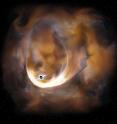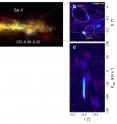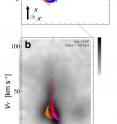Signs of second largest black hole in the Milky Way
Related images
(click to enlarge)
A team of astronomers led by Tomoharu Oka, a professor at Keio University in Japan, has found an enigmatic gas cloud, called CO-0.40-0.22, only 200 light years away from the center of the Milky Way. What makes CO-0.40-0.22 unusual is its surprisingly wide velocity dispersion: the cloud contains gas with a very wide range of speeds. The team found this mysterious feature with two radio telescopes, the Nobeyama 45-m Telescope in Japan and the ASTE Telescope in Chile, both operated by the National Astronomical Observatory of Japan. To investigate the detailed structure, the team observed CO-0.40-0.22 with the Nobeyama 45-m Telescope again to obtain 21 emission lines from 18 molecules. The results show that the cloud has an elliptical shape and consists of two components: a compact but low density component with a very wide velocity dispersion of 100 km/s, and a dense component extending 10 light years with a narrow velocity dispersion.
What makes this velocity dispersion so wide? There are no holes inside of the cloud. Also, X-ray and infrared observations did not find any compact objects. These features indicate that the velocity dispersion is not caused by a local energy input, such as supernova explosions.
The team performed a simple simulation of gas clouds flung by a strong gravity source. In the simulation, the gas clouds are first attracted by the source and their speeds increase as they approach it, reaching maximum at the closest point to the object. After that the clouds continue past the object and their speeds decrease. The team found that a model using a gravity source with 100 thousand times the mass of the Sun inside an area with a radius of 0.3 light years provided the best fit to the observed data. "Considering the fact that no compact objects are seen in X-ray or infrared observations," Oka, the lead author of the paper that appeared in the Astrophysical Journal Letters, explains "as far as we know, the best candidate for the compact massive object is a black hole."
If that is the case, this is the first detection of an intermediate mass black hole. Astronomers already know about two sizes of black holes: stellar-mass black holes, formed after the gigantic explosions of very massive stars; and supermassive black holes (SMBH) often found at the centers of galaxies. The mass of SMBH ranges from several million to billions of times the mass of the Sun. A number of SMBHs have been found, but no one knows how the SMBHs are formed. One idea is that they are formed from mergers of many intermediate mass black holes. But this raises a problem because so far no firm observational evidence for intermediate mass black holes has been found. If the cloud CO-0.40-0.22, located only 200 light years away from Sgr A* (the 400 million solar mass SMBH at the center of the Milky Way), contains an intermediate mass black hole, it might support the intermediate mass black hole merger scenario of SMBH evolution.
These results open a new way to search for black holes with radio telescopes. Recent observations have revealed that there are a number of wide-velocity-dispersion compact clouds similar to CO-0.40-0.22. The team proposes that some of those clouds might contain black holes. A study suggested that there are 100 million black holes in the Milky Way Galaxy, but X-ray observations have only found dozens so far. Most of the black holes may be "dark" and very difficult to see directly at any wavelength. "Investigations of gas motion with radio telescopes may provide a complementary way to search for dark black holes" said Oka. "The on-going wide area survey observations of the Milky Way with the Nobeyama 45-m Telescope and high-resolution observations of nearby galaxies using the Atacama Large Millimeter/submillimeter Array (ALMA) have the potential to increase the number of black hole candidates dramatically."
Source: National Institutes of Natural Sciences
Other sources
- Milky Way's Second Most Massive Black Hole Found?from Space.comTue, 19 Jan 2016, 20:48:50 UTC
- Most luminous galaxy is being torn apart by a black holefrom CBSNews - ScienceMon, 18 Jan 2016, 17:10:35 UTC
- Stephen Hawking: Black Holes Have 'Hair'from Space.comFri, 15 Jan 2016, 20:01:00 UTC
- Signs of Second Largest Black Hole in the Milky Wayfrom Newswise - ScinewsFri, 15 Jan 2016, 18:41:26 UTC
- Scientists find evidence of second biggest black hole in Milky Wayfrom UPIFri, 15 Jan 2016, 18:33:45 UTC
- Most Luminous Galaxy Is Ripping Itself Apartfrom NASA Jet Propulsion LaboratoryFri, 15 Jan 2016, 15:30:36 UTC
- Signs of second largest black hole in the Milky Way: Possible missing link in black hole evolutionfrom PhysorgFri, 15 Jan 2016, 14:44:31 UTC
- Signs of second largest black hole in the Milky Wayfrom Science DailyFri, 15 Jan 2016, 14:27:32 UTC
- Stephen Hawking: Black Holes Have 'Hair'from MSNBC: ScienceThu, 14 Jan 2016, 22:30:34 UTC
- Stephen Hawking: Black Holes Have 'Hair'from Live ScienceThu, 14 Jan 2016, 13:50:34 UTC


